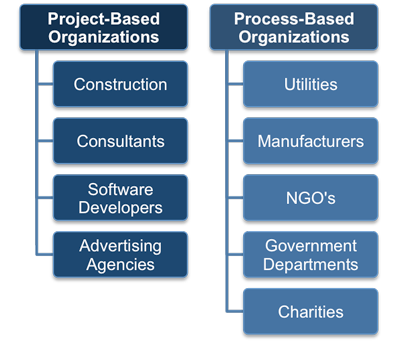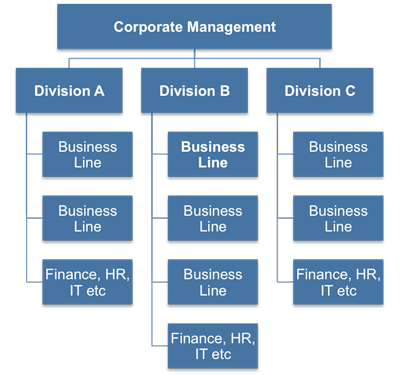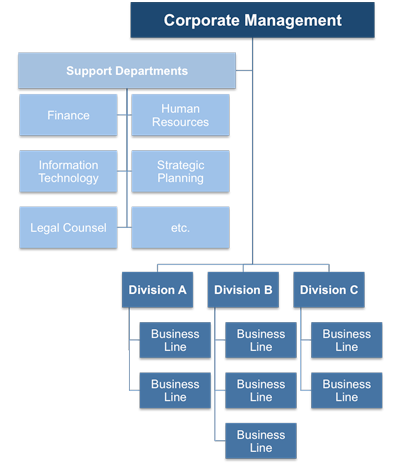Project Organization and Structure
The way in which an organization is structured is largely a result of whether its day-to-day work is process driven or project driven.
 |
Project Focused
These organizations' day-to-day work involves delivering unique projects for external customers for a set time period. Their management structure is designed to support projects and everyone working in the organization is assigned to one or more projects. Examples include: Construction companies, Consulting organizations, Software developers, and Advertising agencies.
Process Focused
The day-to-day work of these organizations predominantly involves continually delivering products or services for external customers. Their management structure is designed to support the process required to deliver the product or service to the end customer. Examples include: Utility companies, Manufacturing companies, Government departments, Charities, and NGOs.
In reality, even the most process-focused organizations will run occasional projects and some may have parts of the organization that are dedicated to project-based working. The vast majority of the staff in public utilities (electricity, gas, and water) will be employed to provide an ongoing service to their customer base. But there will be some areas of the business concerned with physical or management infrastructure that are wholly project driven. For example:
Staff responsible for the development of new information systems and those responsible for the construction of new physical infrastructure, like electrical substations and water treatment plants.
The extent to which your organization has the necessary assets and processes to conduct successful projects will play a significant role in your project costs and level of risk. The less experience it has, the higher your project costs will be and the greater degree of risk compared to a project-driven organization.
Every organization is unique and these classifications are only useful in that they illustrate the fact that project management is likely to present more of a challenge in process-focused organizations than in those that are project focused.
It is better to think of organizational structures existing on a continuum as described below. This is not only more realistic but it allows us to begin thinking about how exactly the organizational structure will impact a project in practical terms.
At one extreme are organizations in which employees are isolated within their department or division as shown.
 |
In this scenario, senior management allocate capital to each division, which then operate autonomously to return as much profit as possible. Each division is completely independent of the others and there is no mechanism to allow communication across divisions other than by going up the hierarchy to senior management who would then have to pass the decision down to the other divisions.
This type of structure makes producing a limited amount of products or services efficient and predictable, but would make it almost impossible to run a project that cut across divisional boundaries.
A refinement of this structure is shown below and is referred to as a weak matrix. This is because although each division operates independently, they no longer have direct control over support functions like IT, finance, and human resources.
This type of structure makes sense because these support functions do not need to be duplicated and can be shared between the divisions. This saves money and enables the support departments to be bigger and employ more specialist staff.
 |
The implication for project management is that there will be mechanisms for communicating across divisions and that people will be more accepting of working with others outside of their own division.
You may also be interested in:
Project Management Principles | Project Management Definition | Project Management Perspectives | Project Organization and Structure | Projects in a Matrix-Management Environment | Project Stakeholders Definition | Project Sponsor Definition | Project Life Cycle Definition | Functional Areas of Project Management.
|
|


